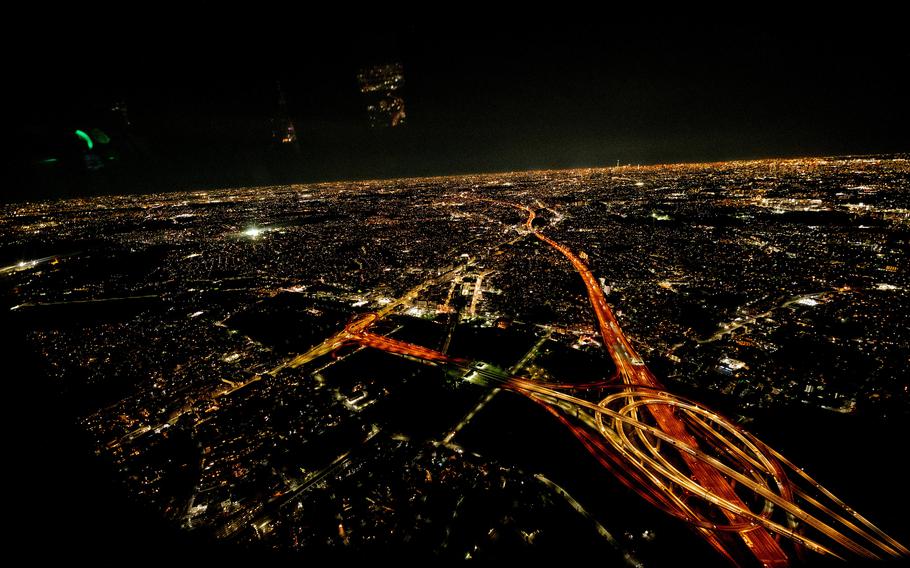
Western Tokyo is seen from the air during a patient transport drill from Yokota Air Base, Japan, Dec. 18, 2023. (Manuel Zamora/U.S. Air Force)
YOKOTA AIR BASE, Japan — July Fourth was a day for cookouts and fireworks, but for pilots and health care professionals at this airlift hub in western Tokyo, it was a day to set a record.
Working together, the 459th Airlift Squadron and the 374th Medical Group used a UH-1 Iroquois, or Huey, to fly a critically ill patient from Yokota to Yokosuka Naval Base for emergency care, according to Lt. Col. Samuel Shamburg, the airlifters’ commander.
The two Air Force units normally have an hour to prepare a patient and be ready for take-off, but in this case trimmed that to 39 minutes, a new record for a medevac from the air base, Shamburg told Stars and Stripes during a July 24 interview at Yokota.
“This is one of the reasons we become helicopter people — it’s very fulfilling,” he said. “That’s time that we limit a patient from being in agony or time we reduce getting the patient into the operating room. It’s all about helping people.”
The patient had a septic joint — an infection that can travel through the bloodstream to another part of the body.
If not treated quickly, a septic patient can lose a limb, Capt. Omar Vargas, commander of the 374th Medical Urgent Care Flight and the patient’s transport nurse, said during the interview.
“It’s a great feeling knowing that somebody’s limb was saved,” he said. “The two units came together to get this person taken care of and that’s very special.”
Vargas’ role as a transfer nurse includes ensuring patients are stable during the ride and monitoring their status.
“We’re always watching and checking vital signs and making sure their pain is under control,” he said.

Air Force medics prepare to board a UH-1N Iroquois, or Huey, helicopter during a patient transport drill at Yokota Air Base, Japan, Dec. 18, 2023. (Manuel Zamora/U.S. Air Force)
Since 2018, the two units have successfully completed 16 medical transport missions, Shamburg said.
On Dec. 15, they started providing 24/7 patient transfers from the base hospital to other military treatment facilities in the region, Shamburg said.
A helicopter medevac significantly reduces patient travel time. From Yokota to Yokosuka is an 18- to 22-minute flight, versus a 2 ½ to three-hour drive through the busy greater metro Tokyo area.
“It’s great for us,” Vargas said. “Time is a big factor for any type of emergency. The quicker you get into the care that they need, the better results for patients. Time is of the essence. So, they [the 459th Airlift Squadron] help us out all the time.”
The medical group always has a transfer nurse on call and the squadron has day and night shifts.
“You are always on standby,” Shamburg said. “So, it’s like a heightened sense of awareness. And just trying to meet that is one of the hardest parts.”
The squadron also trains with the III Marine Expeditionary Force and the medical clinic at Combined Arms Training Center Camp Fuji, Shamburg said.
“They have a very similar problem as we do here and that’s access to care to local hospitals,” he said. “We are interested in expanding into our portfolio where, if something happens up there, we fly up there and work with their medics.”